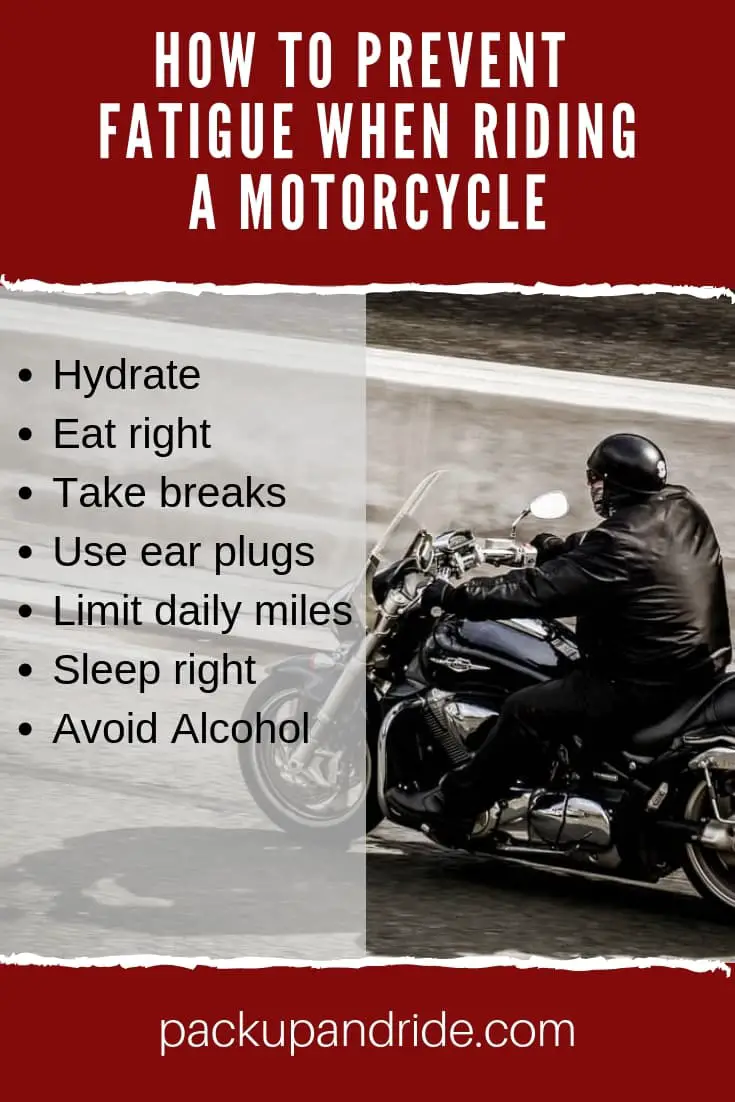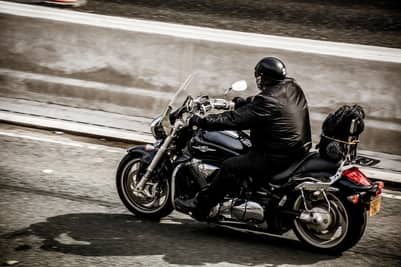You may someday find yourself riding home from an incredible weekend motorcycle trip, trying your best to make it home in one day when in reality you should have given yourself an extra day to make the trip. Suddenly fatigue sets in.
You’re tired, sluggish, sleepy. I’m guilty of it, and the last few hours of those kinds of days are torture as fatigue sets it. Not only is it uncomfortable, but it is also dangerous! Getting adequate sleep is so important to fighting fatigue and reducing motorcycle accidents.
So, how can you prevent fatigue when riding a motorcycle? Fatigue, one of the top 5 causes of fatal motorcycle accidents, can be caused by lack of sleep, dehydration, extreme hot or cold weather, eating the wrong foods or drinking sugary or alcoholic beverages.
These, and a combination of other factors can cause a rider to become sluggish and sleepy, creating a very unpleasant and unsafe riding experience.
In this article, we’ll talk about how you can recognize fatigue and give you some tips on how to prevent it.
The first thing you need to know is how to recognize if you’re getting dangerously tired on the bike. Falling asleep in the saddle doesn’t just suddenly happen as if someone passes out and falls over. Nope, it happens gradually.
In fact, our brains have an amazing way of shutting down when it’s sleep-deprived, while our bodies just, kind of, keep doing their thing. So, you need to know how to recognize the signs BEFORE you are in a dangerous situation.
The National Sleep Foundation has put out a set of warning signs for you to look for, that will tell you that maybe it’s time to get off the road and take a break or get some sleep.
Look for these warning signs of motorcycle fatigue:
- Difficulty focusing – blurry vision, frequent blinking, or that feeling of heavy eyelids
- Daydreaming – your mind wanders and your thoughts are disconnected
- Trouble remembering the last few miles driven – you miss an exit or miss a traffic sign
- Yawning repeatedly or you feel like rubbing your eyes
- Slouching – riding with bad body position or having a hard time keeping your head up
- Drifting from your lane, tailgating, or hitting a shoulder rumble strip
- Feeling restless and irritable
If you’re feeling any of those symptoms, or a combination of them, then you need to make a decision on whether to stop for the night, stop for a power nap, or keep on going and risk getting into what could be a serious accident.
Below you’ll find some great tips for preventing fatigue while riding your motorcycle. It starts long before you put on your gear and get on the bike. In fact, it starts at least 8 hours before you start your ride.
7 Ways to Beat Motorcycle Fatigue
- Get a good night’s sleep
- Hydrate
- Eat Right
- Take Breaks
- Wear Ear Plugs
- Avoid the Highway
- Limit the miles you ride in a day
1. Get a good night’s sleep
The importance of a good night’s sleep cannot be underestimated. Sleep studies have shown that driving while drowsy is similar to driving while under the influence of alcohol or drugs.
Two consecutive nights with 6 hours of sleep or less, can reduce a driver’s ability to stay focused and reduce reaction time. Most of the sleep studies involve cars, so it’s fair to assume that the effects are amplified when riding a motorcycle. To fall asleep early on a multi-day ride is a habit worth keeping.
Because riding requires a higher level of concentration and requires you to stay even more alert than the average cager, sleep is a must. I know it’s tempting to stay up late and hang out with your riding buddies and talk about the day’s ride, but if you hit the sack early, you’ll enjoy tomorrow’s ride that much more. So, lights out at 11 PM guys!
2. Hydrate
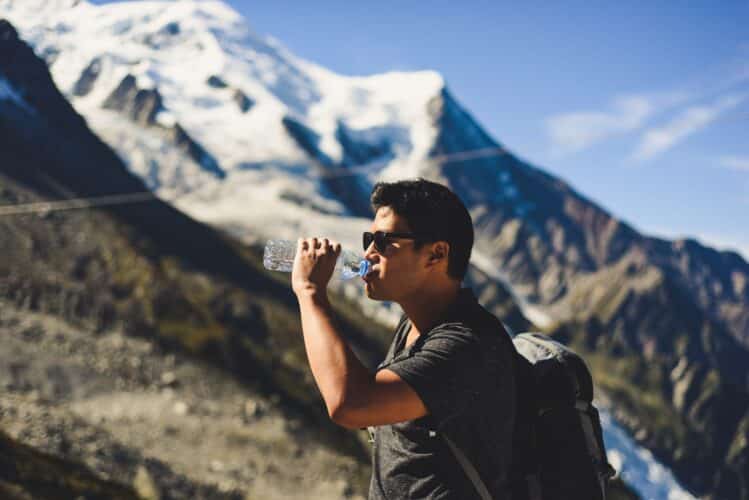
This is another tip that starts before you get on the bike. Don’t over-do it on the alcohol the night before. You don’t want to start your morning with a hang over and already dehydrated. So, enjoy yourself, but don’t over-indulge. While on your ride there are certain drinks you should avoid. Alcohol is one of them.
And, while I’ve been riding with people who may have a beer during lunch, I have a hard and fast rule for myself: save the beer for after you park it for the day. It’s also a good idea to avoid sugary drinks like soda and energy drinks as these can give you an initial boost, but cause your energy level to plummet later in the day.
A sugar low doesn’t happen when you don’t have enough sugar, it happens from having too much sugar and then feeling the consequences afterward.
To drink alcohol and not go to sleep at a reasonable hour and then expect to be doing something as physically demanding as riding a motorcycle for hours on end is just asking for trouble and will ultimately lead to a crash.
So, what should you drink?
Water. Just drink plain old water. This seems like a pretty simple concept but you would be surprised at how many people forget to drink water. The amount of water you drink is going to depend on things like the outside temperature, how in shape you are, and the humidity.
There are a lot of opinions on how much water you should drink in a day, but the most commonly agreed-upon amount is about 2 liters or a half-gallon per day. When you’re active, as you are when you’re riding, you will need to drink more. And even more, if it is hot or humid. I personally like to carry my 2 liters CamelBak when I ride. That makes it simple to drink often. No need to remove the helmet.
One way to make sure you’re drinking enough is to make sure you are urinating throughout the day. If you’re drinking water, but you’re not peeing, then you’re not drinking enough. Also, if it’s a really hot day, or if it’s humid, chug down an electrolyte drink to replenish the sodium and potassium that you’re sweating away.
3. Eat Right
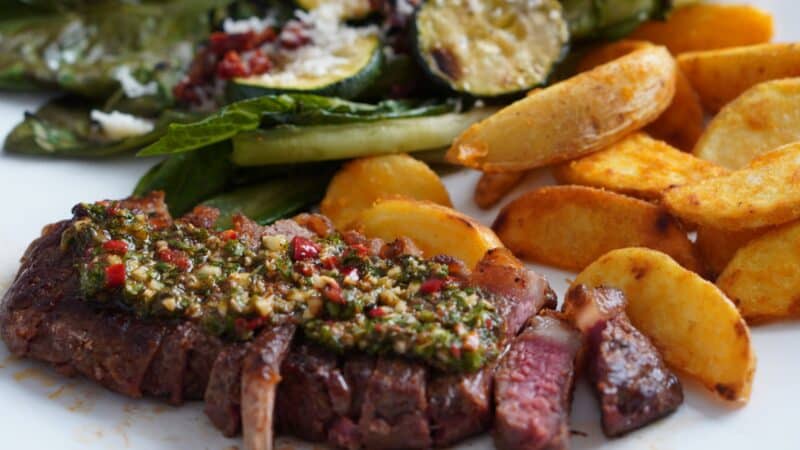
Before you ride, eat a good breakfast; one that will keep your energy level consistent for the morning. No, that doesn’t mean donuts and coffee.
It means a good balance of proteins, carbs, fruit…and coffee. Also, don’t chow down on a huge lunch only to find yourself in a food coma an hour later. And here’s a big one, avoid carbohydrate-heavy foods. carb-loading is really good at putting you in a food coma.
Eat light, and snack often. Carry some healthy snacks with you to keep your energy level up. Trail mix, a protein bar, or even a Snickers if you have a sweet tooth. The trick is to eat small portions more often, rather than eating one big meal.
4. Take Breaks
Sitting on the motorcycle for long periods of time can cause you to zone out and get sleepy. So, it’s a good idea to plan plenty of breaks throughout your ride. A good rule of thumb is to take a break every 1 to 2 hours. While you’re on that break, walk around, stretch, get the blood flowing again.
Also, if you can stand up on your motorcycle while riding, this is a great way to get the blood flowing in between breaks.
Taking breaks is a lifesaver when fighting fatigue. These can include regular toilet breaks or light exercise breaks, especially on extended rides when you become a more vulnerable rider
5. Wear Ear Plugs
Wearing earplugs will not only save your hearing but, reduce the stress of listening to the loud wind and engine noise will reduce fatigue and help keep you alert and awake. Some might speculate that earplugs will make you less safe. How can you hear your engine, or a siren, or horn?
Actually, when you reduce those louder noises, your ears are able to concentrate more on the subtle noises, like sirens or horns. Wear earplugs to block out wind noise and loud pipes and keep you mentally alert.
Earplugs have evolved quite a bit over the years. You could still use the basic, disposable foam earplugs that you squish between your finger then cram them in your ear canal.
Those work just fine, they are easy to find and they cost next to nothing. But you can also use acoustic earplugs or musician’s earplugs. These will filter out the loudest noises, but let the more subtle noises in. These are great if you’re using an intercom system or listening to music through helmet speakers.
6. Avoid the Highway
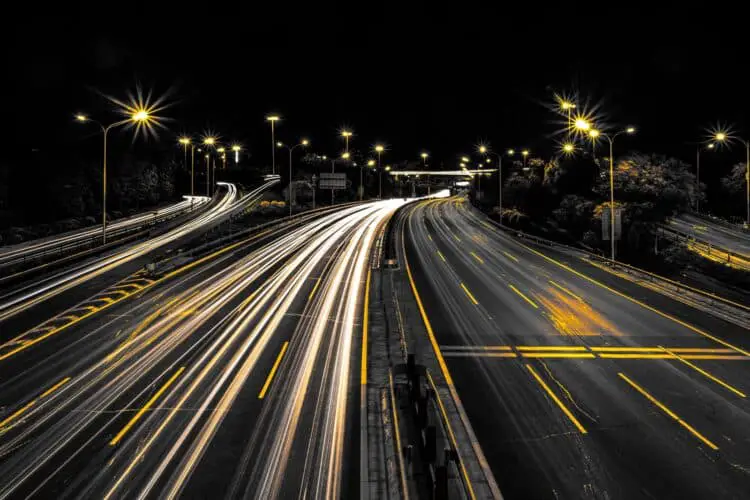
Take a more interesting route instead of slabbing it on a long, boring freeway full of other sleepy drivers and big trucks. Riding on more technical roads will keep your senses alive and your mind and body alert. Besides, this is why we ride.
We want to see the off-beaten path, that beautiful winding canyon road. But, if you can’t avoid a ride on the highway, make sure you’re not stuck behind the same car for a long time. Don’t tailgate. Don’t zone out. Go ahead and hit the throttle and pass up those slow drivers and give yourself a little boost of adrenaline at the same time.
The worse thing you can do to yourself is to put yourself in a situation where if you fall asleep even for a second you’ll have a crash!
Another little tip is to avoid cruise control on highways. I know cruise control is a luxury most of us don’t have, but even if you do, avoid it when you haven’t had adequate sleep. Driver aids like cruise control might seem nice but are the worst for losing concentration.
This leads us to the last tip:
7. Limit the miles you ride in a day
This is great advice especially if you are riding twisty roads or technical terrain. 10 miles of dirt roads will wear you out a lot faster than 10 miles of smooth pavement. And 10 miles of mountain switchbacks that require a lot of concentration will also take their toll. Get adequate rest on days that are mentally more taxing.
So, plan your route ahead of timekeeping that in mind. If you’re riding with a group, be prepared to shorten your route based on the speed and ability of the slowest rider in your group.
Lastly, if you need to be home from your trip in time to clock in for work the next morning, consider reducing your miles for that last day. Plan your route accordingly. If you’re on a longer trip, consider adding a rest day to the end of your ride.
This will give you some wiggle room. If you find yourself getting dangerously fatigued, you have the option of stopping for the night. To fall asleep while riding is the scariest feeling out there.
Summery
I hope you found these tips helpful. Remember to practice these tips, stay awake and stay safe. Getting adequate rest on a long ride is better protection than a full-face helmet (in my opinion). wind noise, physical fatigue, and even what you eat can cause slower body motor skills.
